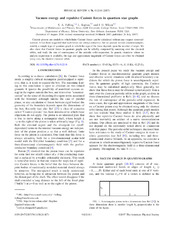| dc.creator | Fulling, Stephen | |
| dc.creator | Kaplan, L. | |
| dc.creator | Wilson, J. H. | |
| dc.date.accessioned | 2011-09-08T21:36:27Z | |
| dc.date.available | 2011-09-08T21:36:27Z | |
| dc.date.issued | 2007 | |
| dc.identifier.citation | Stephen Fulling, L. Kaplan and J. H. Wilson. Phys.Rev.A 76 012118 2007. "Copyright (2007) by the American Physical Society." | en |
| dc.identifier.uri | http://dx.doi.org/10.1103/PhysRevA.76.012118 | |
| dc.identifier.uri | https://hdl.handle.net/1969.1/126609 | |
| dc.description | Journals published by the American Physical Society can be found at http://publish.aps.org/ | en |
| dc.description.abstract | Casimir pistons are models in which finite Casimir forces can be calculated without any suspect renormalizations. It has been suggested that such forces are always attractive, but we present several counterexamples, notably a simple type of quantum graph in which the sign of the force depends upon the number of edges. We also show that Casimir forces in quantum graphs can be reliably computed by summing over the classical orbits, and study the rate of convergence of the periodic orbit expansion. In generic situations where no analytic expression is available, the sign and approximate magnitude of Casimir forces can often be obtained using only the shortest classical orbits. | en |
| dc.language.iso | en | |
| dc.publisher | American Physical Society | |
| dc.subject | ZERO-POINT ENERGY | en |
| dc.subject | SPECTRAL STATISTICS | en |
| dc.subject | KIRCHHOFFS RULE | en |
| dc.subject | WIRES | en |
| dc.subject | Optics | en |
| dc.subject | Physics | en |
| dc.title | Vacuum energy and repulsive Casimir forces in quantum star graphs | en |
| dc.type | Article | en |
| local.department | Physics and Astronomy | en |


